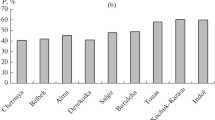Abstract
A model for simulating the response of monthly runoff from the mountainous watersheds to climatic changes is developed. The model is based on the modifications to the HBV runoff model, and therefore represents the characteristics and runofF generation processes of inland river basins in the arid area of northwest China. Talcing the mountainous watershed of an inland river, the Heihe River originating from the Qilian Mountains and running through the Hexi Corridor as an example, the monthly runoff changes under different climate scenarios are simulated. The simulation indicates that, during the years fmm 1994 to 2030, if the annual mean air temperature increases by 0.5°C, and precipitation keeps unchanged, then the runoff of May and October will increase because of the increase of the snow melt runoff, but the runoff of July and August will decrease to some extent because of the increase of evaporation, and as a result, the annual runoff will decrease by 4%. If the precipitation still keeps unchanged, and the air temperature increases by 1.0°C, in addition to the increase of runoff of May and June, the runoff of July and August will decrease in a larger amount, making the annual runoff decrease by 7.11%. If the air temperature keeps unchanged, the increase of annual precipitation by 10% will cause the increase of runoff by 5.27%; while the increase of precipitation by 20% will cause the increase of runoff by 12.35 %. When the air temperature increases by 0.5°C: and the precipitation increases by 10%, the mnoff will increase only by 1.62%.
Similar content being viewed by others

References
Arnell, N., Bates, B., Lang, H. et al., Hydrology and freshwater ecology, inClimate Change (eds. Watson, R. T., Zinyowera, M. C., Moss, R. H. et al.), Cambridge: Cambridge University Press, 1996, 327–328.
Shi Yafeng,Impact of Climate Changes on the Water Resources in Northwest and North China (in Chinese), Jinan: Shandong Science and Technology Press, 1995, 343–344.
Lai Zuming, Ye Baisheng, Evaluating the water resources impacts of climatic warming in cold alpine regions by the water balance model: modeling the Urumqi River Basin,Science in China, Ser. B, 1991, 34(11): 1362.
Bergstmm, S.. Development and application of a conceptual runoff model for Scandinavian catchments,Bulletin Seriea A, No. 52, Lund: University of Lund, 1976, 12–83.
Braun, L. N.,Simulation of Snowmelt- Runoff in Lowland and Lower Alpine Regions of Switzerland, Zurich: ETH, 1985, 1–50.
Braun, L. N., Grabs, W., Rana, B., Application of a conceptual precipitation-runoff model in the Langtang Khola Basin, Nepal Himalaya,IAHS Publ., 1993, 218: 221.
Yang Zhenniang, Glacier water resources and effect of glacier water in stream runoff in Qilian Mountain,Memoirs of Lanzhou Institute of Glaciology and Geocryology, Chinese Academy of Sciences (in Chinese), No. 7, Beijing: Science Press, 1992, 10–19.
Yang Daqing, Shi Yafeng, Kang Ersi et al., Analysis and correction of systematic errors in precipitation measurement in the Ummqi River basin, Tianshan, inFormation and Estimation of Mountain Water Resources in the Urumqi River Basin (in Chinese) (eds. Shi Yafeng, Kang Ersi, Zhang Guowei et al.), Beijing: Science Press, 1992, 14–40.
Kang Ersi, Energy-water-mass balance and hydrological discharge, Zurich: ETH, 1994, 53, 74–75, 82–85.
Kang Ersi, Omura, A., Energy, water and mass balance and runoff modelling in a glacierized basin of Tianshan mountains,Science in China (in Chinese), Ser. B, 1994, 24(9): 986.
Kang Ersi, Ohmura, A., A parameterized energy balance model of glacier melting on the Tianshan mountain,Acta Geogrophica Sinica (in Chinese), 1994, 49(5): 467.
Tan Guanri,Applied Climatology (in Chinese), Shanghai: Shanghai Science and Technology Press, 1985, 194–195.
Zhang Guowei, Maire Yanmu, Estimation of evaporation and analysis of its characteristics in the mountainous area of the Ummqi River basin, inFormation and Estimation of Moumain Water Resources in the Urwnqi River Bmin (in Chinese) (eds. Shi Yafeng, Kang Ersi, Zhang Guowei et al.), Beijing: Science F’ress, 1992, 90–98.
Author information
Authors and Affiliations
Additional information
Project supported by the Ministry of Science and Technology of China (Grant No. 96-912-01-02)
Rights and permissions
About this article
Cite this article
Kang, E., Cheng, G., Lan, Y. et al. A model for simulating the response of runoff from the mountainous watersheds of inland river basins in the arid area of northwest China to climatic changes. Sci. China Ser. D-Earth Sci. 42 (Suppl 1), 52–63 (1999). https://doi.org/10.1007/BF02878853
Received:
Issue Date:
DOI: https://doi.org/10.1007/BF02878853


